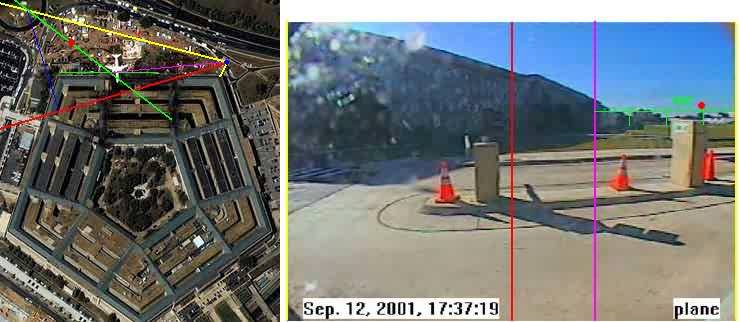From a
Previous post of mine.
Let's break this down:
The max cruising speed of a Boeing 757 is about 570 mph (914km/h). According to the FAA report, American Airlines flight 77 was last reported doing 459 kts - or 527 mph - at 8:56 AM. Just prior to the strike, the jet passed over the White House then completed a hair-pin 270 degree turn before slamming into the Pentagon. This hair-pin turn would have bled-off a lot of their air-speed, however the dive into the Pentagon with engines at full thrust might have brought the final approach speed back up to around 527 mph (459 kts).
Inbound Velocity: 600 miles/hour = 10 miles/minute = 1 mile or 5280 feet every 6 seconds = 880 feet/sec.
Now NTSA standards which are used in 99% of all North American A/V equipment operates at a rate of 30 interlaced frames per second. That is one complete frame every 30th of a second and one partial or interlaced field scan every 60th of a second, which is essentially slaved to our AC frequency of 60 Hz.
So if you take the plane's velocity of 880 feet/sec. and divide that by the full frame rate of 1/30th of a second, the camera will capture a complete image of the plane every 29.3 feet, given a constant speed of 600 mph. Or if your video equipment can freeze-frame on individual interlace fields it will capture a partial scan (every other scan line) of the plane's travel in 14.6 foot intervals, given a constant rate of speed of 600 mph.
Now according to the surveillance video the plane was crossing the camera's field of view on an inbound trajectory of approximately 35 - 45 degrees, so the apparent velocity of the plane across the camera's field of view will be approximately 1/3 less than that actually travelled by the plane along it's inbound trajectory.

Blue Dot: Camera Position
Red Line: Centerline of Field of View
Yellow Lines: Approx. Field of View Borders
Green Line: Approx. Path of AA77
Red Dot: Tail Position in Photograph
Pink Line: Angle from Camera to Point of Impact
Using the sky view and the surveillance camera views above we determine the approximate angles involved to assist us with determining how far the plane travelled in a single frame or 1/30th of a second. Now assuming the photo was not doctored and assuming this is AA77 (not a small commuter jet) partially hidden behind the traffic post, we will use the length of the 757-300 as our base measurement, which is 155 feet. It can been seen in the video frame that there are approximately 2 plane lengths (310 feet) remaining between the nose and the building face and 3 plane lengths (465 feet) between the tail and the building face.
In the following frame 1/30th of a second later, the tail of the plane has completely disappeared into the building and resulting explosion, so obviously the tail of the plane had to have travelled a minimum of 465 feet in 1/30th of a second. And keep in mind we are not factoring in the extra distance resulting from the tangent the flight path is on perpendicular to the camera angle or the deceleration that would suddenly occur as the plane struck the building. So remember, these figures are very conservative.
Now let's work backwards to see what the minimum approach velocity of AA77 would have to be in order for these two "undoctored", "back-to-back" video frames to be captured exactly as we have been told they were by government officials.
465 feet traveled in 1/30th of a second = 13,950 feet/second = 2.64 miles/second = 158.5 miles per minute = 9511.36 mph = 8263.5 kts. = Mach 12.48
So either 1-2 seconds of the video were removed, it was not a boeing 757, or we have been in holding patterns a lot longer than we know.
 http://www.cyberspaceorbit.com/math_geometry.html
http://www.cyberspaceorbit.com/math_geometry.html